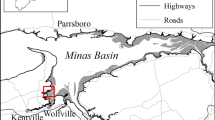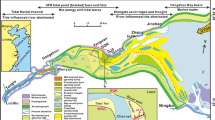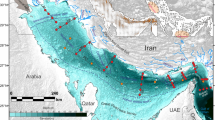Abstract
Grain size distribution patterns along the East Frisian coast (German Wadden Sea) were evafuated with the aim of identifying potential effects of man-made structures (e.g. dikes) on the textural composition and sediment budget of the area. It was found that the distribution of various grain size fractions and settling velocities revealed a well-defined cross-shore energy gradient. Adjacent to the mainland dike the sediment is dominated by the 3.0–3.5 phi sand fraction (>70% by weight). In comparison to the sedimentary sequences normally observed in unobstructed backbarrier depositional environments, the sediments along the land-ward margin are in this case conspicuously depleted in grain sizes <3.5 phi, the corresponding size fractions contributing <20% by weight. This suggests that the dike interrupts the normal energy gradient, thereby inhibiting the deposition of sediments with settling velocities <0.5 cm s−1. This interpretation is confirmed when comparing individual cross-shore transects. The shorter the transect between the barrier island shore and the dike, the greater the fine sediment depletion. Since many faunal assemblages are grain-size specific, it is further suggested that the backbarrier ecosystem must have undergone significant modifications as a result of the substantial reduction in mud flats since the onset of dike construction some 1000 years BP. It is predicted that in the wake of the persisting and possibly accelerating sealevel rise this process of fine sediment depletion will continue and also affect progressively coarser sediments.
Similar content being viewed by others
References
BREZINA, J., 1979. Particle size and settling rate distributions of sand-sized materials. PARTEC, 2nd Europ. Symp. on Particle Characterisation, Paper Session 1: 1–21.
CARVER, R.E., 1971. Procedures in sedimentary petrology. Wiley-Interscience, New York.
DIECKMANN, R., 1985. Geomorphologie, Stabilitäts- und Langzeitverhalten von Watteinzugsgebieten der Deutschen Bucht. Mitteilungen des Franzius Instituts für Wasserbau und Küsteningenieurwesen der Technischen Universität Hannover. 60: 133–361.
EISMA, D., 1993. Suspended matter in the aquatic environment. Springer, New York, 315 pp.
EVANS, G., 1965. Intertidal flat sediments and their depositional environments in the Wash. Quart. Jour. Geol. Soc. London, 121: 209–241.
FITZGERALD, D.M., S. PENLAND, and D. NUMMEDAL, 1984. Changes in tidal inlet geometry due to backbarrier filling: East Frisian islands. West Germany. Shore and Beach, 52: 2–8.
FLEMMING, B.W., 1991. Zur holozänen Entwicklung Morphologie und faziellen Gliederung der ostfriesischen Insel Spiekeroog (südliche Nordsee). Senckenberg am Meer, Bericht 91/3. 51 p.
FLEMMING, B.W. and R.A. DAVIS, 1994. Holocene evolution, morphodynamics and sedimentology of the Spiekeroog barrier island system (southern North Sea). Senckenbergiana marit., 24: 117–155.
FLEMMING, B.W. and A. THUM, 1978. The settling tube — a hydraulic method for grain size analysis of sands. Kieler Meeresforsch Sonderband 4: 82–95.
FLEMMING, B.W. and K. ZIEGLER, 1995. High resolution grain size distribution patterns and textural trends in the backbarrier region of Spiekeroog Island, southern North Sea. Senckenbergiana marit. (in press).
FLEMMING, B.W., H. SCHUBERT, G. HERTWECK, and K. MÜLLER. 1992. Bioclastic tidal-channel lag deposits: a genetic model. Senckenbergiana marit., 22: 109–129.
HÄNTZSCHEL, W., 1955. Tidal flat deposits (Wattenschlick). In: P.D. Trask, Ed., Recent marine sediments. S.E.P.M., Spec. Publ., 1: 195–206.
HAYES, M.O., 1975. Morphology of sand accumulations in estuaries. In: L.E. Cronin, Ed., Estuarine Research. Academic Press, New York, p. 3–22.
HAYES, M.O., 1979. Barrier island morphology as a function of tidal and wave regime. In: S.P. Leatherman, Ed., Barrier Islands. Academic Press, New York, p. 1–27.
KELLERHALS, P. and J.W. MURRAY, 1969. Tidal flats at Boundary Bay, Fraser River delta, British Columbia. Can. Petrol. Geol. Bull. 17: 67–91.
KINEKE, G.C., R.W. STERNBERG and R. JOHNSON, 1989. A new instrument for measuring settling velocities in situ. Mar. Geol., 90: 149–158.
KRAFT, J.C., 1971. Sedimentary facies patterns and geologic history of a Holocene marine transgression. Geol. Soc. Am. Bull., 82: 2131–2187.
KRAFT, J.C., R.B. BIGGS and S.D. HALSEY, 1973. Morphology and vertical sedimentary sequence models in Holocene transgressive barrier systems. In: D. Coates, Ed., Coastal Geomorphology. State Univ. New York Publ. in Geomorphology, Binghamton, p. 321–354.
KRAFT, J.C. and C.J. JOHN, 1979. Lateral and vertical facies relations of transgressive barrier. A.A.P.G. Bull., 63: 2145–2163.
KRAFT, J.C., E.A. ALLEN, D.F. BELKNAP, C.J. JOHN and E.M. MAURMEYER, 1979. Processes and morphologic evolution of an estuarine and coastal barrier system. In: S.P. Leatherman, Ed., Barrier Islands. Academic Press, New York, p. 149–183.
LOUTERS, T., J.P.M. MULDER, R. POSTMA and F.P. HALLIE, 1991. Changes in coastal geomorphological processes due to the closure of tidal inlets in the SW Netherlands. J. Coast. Res., 7: 635–652.
LUCK, G., 1975. Der Einfluß der Schutzwerke der Ostfriesischen Inseln auf die morphologischen Vorgänge im Bereich der Seegaten und ihrer Einzugsgebiete. Mitt. Leichtweiß-Inst. f. Wasserbau der T.U. Braunschweig, 47: 1–122.
LUCK, G., 1976. Inlet changes of the East Frisian islands. Proc. 15th Conf. Coastal Engr., A.S.C.E., New York, Vol 2, p. 1938–1957.
McCANN, S.B., 1979. Barrier islands in the southern Gulf of St. Lawrence, Canada. In: S.P. Leatherman, Ed., Barrier Isalnds. Academic Press, New York, p. 29–63.
NICHOLS, M.M. and R.B. BIGGS, 1985. Estuaries. In: R.A. Davis, Ed., Coastal Sedimentary Environments. Springer, New York, p. 77–186.
OWEN, M.W., 1971. The effect of turbulence on floc settling velocities. Paper D4, Proc, 14th Congr. Intl. Assoc. Hydraulic Res., Paris. D4-1–D4-6.
POSTMA, H., 1961. Transport and accumulation of suspended matter in the Dutch Wadden Sea. Neth. J. Sea Res., 1: 148–190.
REINECK, H.-E., 1967. Layered sediments of tidal flats, beaches and shelf bottoms of the North Sea. In: G.H. Lauff, Ed., Estuaries. Am. Assoc. Adv. Sci., Spec. Publ., 83: 191–206.
REINECK, H.-E., 1972. Tidal flats. In: J.K. Rigby and W.K. Hamblyn, Eds., Recognition of ancient sedimentary environments. S.E.P.M., Spec. Publ., 16: 146–159.
REINECK, H.-E. and I.B. SINGH, 1973. Depositional sedimentary environments. Springer Verlag, Berlin, 439 p.
REINECK, H.-E. and W. SIEFERT, 1980. Factoren der Schlickbildung im Sahlenburger und Neuwerker Watt. Die Küste, 35: 26–51.
REINECK, H.-E., C.M. CHEN and S.S. WANG, 1986. Die Rückseitenwatten zwischen Wangeroog und Festland, Nordsee. Senckenbergiana marit., 17: 241–252.
RENGER, E., 1976. Quantitative Analyse der Morphologie von Watteinzugsgebieten und Tidebecken. Mitteilung des Franzius Instituts für Wasserbau und Küsteningenieurwesen der Technischen Universität Hannover, 43: 1–160.
RENGER, E. and H.-W. PARTENSCKY, 1974. Stabilitätsverhalten von Watteinzugsgebieten. Die Küste, 25: 73–86.
SINDOWSKI, K.-H., 1973. Das ostfriesische Küstengebiet: Inseln, Wattenmeer und Marschen. Gebr. Borntärger, Berlin, 162 p.
STREIF, H., 1990. Das ostfriesische Küstengebiet. Nordsee, Inseln, Watten und Marschen. Gebr. Bornträger, Berlin, 376 p.
SWIFT, D.J.P., 1975. Barrier island genesis: Evidence from the middle Atlantic shelf of North America. Sed. Geol., 14: 1–43.
STERNBERG, R.W., D.A. CACCHIONE, D.E. DRAKE and K. KRANCK, 1986. Suspended sediment transport in an estuarine tidal channel within San Francisco Bay, California. Mar. Geol., 71: 237–258.
VAN LEUSSEN, W. and J. CORNELISSE, 1992. Direct measurements of floc sizes and settling velocities of mud flocs in the Ems estuary. Proceedings, Cohesive Sediments Workshop, Florida (April 1991).
VAN STRAATEN, L.M.J.U., 1961. Sedimentation in tidal flat areas. J. Alberta Soc. Petrol. Geolog., 9: 203–226.
VAN STRAATEN, L.M.J.U. and Ph.H. KUENEN, 1957. Accumulation of fine-grained sediment in the Dutch Wadden Sea. Geol. Mijnbouw, 19: 329–354.
WALTHER, F., 1972. Zusammenhänge zwischen der Größe der ostfriesischen Seegaten mit ihren Wattgebieten sowie den Gezeiten und Strömungen. Forschungsstelle Norderney, Jahresbericht für 1971, Band 23: 7–32.
ZAGWIJN, W.H., 1986. Geologie van Nederland, Deel 1: Nederland in het Holoceen. Rijks Geol. Dienst. Haarlem, 46 p.
Author information
Authors and Affiliations
Rights and permissions
About this article
Cite this article
Flemming, B.W., Nyandwi, N. Land reclamation as a cause of fine-grained sediment depletion in backbarrier tidal flats (Southern North Sea). Netherlands Journal of Aquatic Ecology 28, 299–307 (1994). https://doi.org/10.1007/BF02334198
Issue Date:
DOI: https://doi.org/10.1007/BF02334198




